What Animals From Rancho La Brea Still Exist?
Posted by: Loren Coleman on October 7th, 2010
The La Brea tar pits of southern California have revealed and continue to demonstrate an amazing assemblage of megafauna, some of which may have bearing on various cryptid candidates. What ones might be the answer to reports of various unknown animals in the files of cryptozoology? What do you think? Join a Cryptomundo survey of your thoughts.
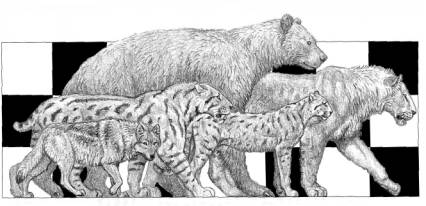
Carnivores of Rancho La Brea.
From left to right. The dire wolf (Canis dirus), the sabre-toothed cat (Smilodon fatalis), the short-faced bear (Arctodus simus), the cheetah-like cat (Miracinonyx sp.), and the American lion (Panthera leo atrox). Modified from Turner, A., and Anton, M., The Big Cats and Their Fossil Relatives. Columbia University Press: New York, 1997.
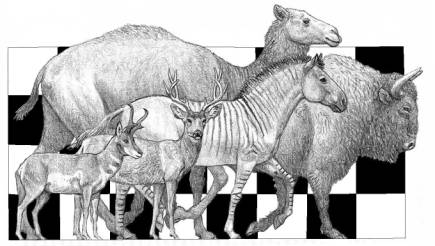
Herbivores of Rancho La Brea.
From left to right. The pronghorn (Antilocapra americana), the deer (Odocoileus sp.), the giant camel (Camelops hesternus), the horse (Equus occidentalis), and the bison (Bison sp.).
Modified from Turner, A., and Anton, M., The Big Cats and Their Fossil Relatives. Columbia University Press: New York, 1997.
What of the finds from other tar pits throughout the Americas?
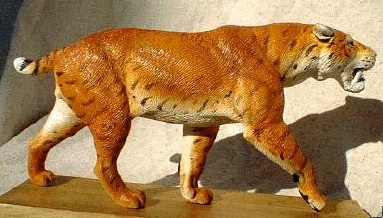
Homotherium
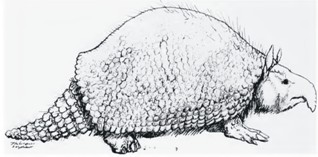

Glyptodons. Sclerocalyptus above.
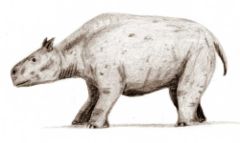
Mixotoxodon
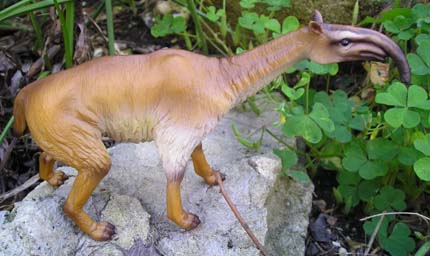
Macrauchenia
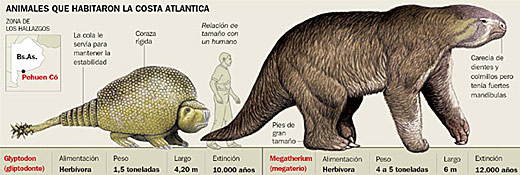
(Read more here.)

Pampatherium
What members of the megafauna of the Rancho La Brea and other tar pits do you think still exist?
About Loren Coleman
Loren Coleman is one of the world’s leading cryptozoologists, some say “the” leading living cryptozoologist. Certainly, he is acknowledged as the current living American researcher and writer who has most popularized cryptozoology in the late 20th and early 21st centuries.
Starting his fieldwork and investigations in 1960, after traveling and trekking extensively in pursuit of cryptozoological mysteries, Coleman began writing to share his experiences in 1969. An honorary member of Ivan T. Sanderson’s Society for the Investigation of the Unexplained in the 1970s, Coleman has been bestowed with similar honorary memberships of the North Idaho College Cryptozoology Club in 1983, and in subsequent years, that of the British Columbia Scientific Cryptozoology Club, CryptoSafari International, and other international organizations. He was also a Life Member and Benefactor of the International Society of Cryptozoology (now-defunct).
Loren Coleman’s daily blog, as a member of the Cryptomundo Team, served as an ongoing avenue of communication for the ever-growing body of cryptozoo news from 2005 through 2013. He returned as an infrequent contributor beginning Halloween week of 2015.
Coleman is the founder in 2003, and current director of the International Cryptozoology Museum in Portland, Maine.










There were two species of Myracinonyx, the cheetah-like one and the puma-like one, this latter could still exist (Onza and maybe also Georgia’s mysterious cat).
I also believe in Megatherium or close relative’s survival as the Mapinguari at least until recent times. Pampatherium, I don’t know, are there any reports of oversized armadillos other than Priodontes maximus?
A potent reminder of just how much potential the latent ecosystem of the American Southwest may still possess. I hope that some day surrogate species are re-introduced to the southwest landscapes, which are now largely under-utilized and missing a number of keystone species for which they have been mutually adapted over millions of years. Camels, lions, cheetahs, tortoises, condors…and yes, even elephants would add not only qualities we associate with wilderness values but would improve the productivity of the land which ultimately creates a more stable and beneficial landscape.
The animals that could still exist are the short faced bear and the dire-wolf.
Since the size of the prey typically determines the size of the wolf (i.e. – Wood Buffalo Park wolves are the largest wolves in N. America), the dire wolf could have evolved to fit a smaller prey diet and may still be around, most likely in Canada, passing itself as a normal grey wolf.
The short faced bear could also still exist, blending in amongst grizzly bears, also most likely in Canada. They weighed about as much as the Kodiak bear, and were only slightly taller at the shoulder.
Camels, lions and sabretooth cats would be hard to miss.
I don’t see them mentioned here, but I am convinced that teratorns of some sort are still around. Several species are known from La Brea. Of course, I think that the teratorn species that is the most likely candidate for Thunderbird sightings is Argentavis magnificens, which is not known from La Brea, but I digress…
Until I start seeing a significant body of consistent encounter reports, I consider it safe to say that nothing found at Rancho La Brea that is considered extinct is anything but extinct.
Focus on the sasquatch. 😉
Oh, DWA, you just can’t help yourself, can you? 😉
Dogu4- Indeed, many of the ecosystems of North America are sorely lacking some keystone species which they not only could fairly smoothly reintegrate, but would also in many cases greatly benefit from having reintroduced.
As you are aware, there have been lots of ideas tossed around for implanting certain surrogate species to replace those that have become extinct in the hopes of “rebuilding” lost ecosystems. This is all great in theory, but there are several obstacles and uncertainties to doing so.
I won’t get too into all of the factors here, but one major problem to overcom is the public’s willingness to accept such introduced species. While some animals such as lions and cheetahs may indeed be healthy for the ecosystems in question, how welcome would they be for the ranchers, farmers, and others who are ever encroaching upon these habitats? I think it would be a major challenge to convince the public that have lions introduced into the wilds of North America would be a good idea, and the public are the ones that have to be convinced before any such plan could get underway.
Look at the situation with large predators today in North America and outside of a few well protected areas, the general trend has been for large, apex predators to be persecuted and pushed out. In many cases reintroducing wolves would be raise public alarm, let alone lions and cheetahs.
In theory, recreating these lost ecosystems is in some ways an excellent idea. However, in this modern age it is not going to be an easy sell to an anxious public that continually whittles away at the last wild places that remain.
Ah, but one can dream can’t they? 😉
With the recent excavation of frozen Mammoths from Siberia, it would be a hoot if genetic biologists could re-insert their DNA into their modern cousins and resurrect them.
From years past, I clearly recall numerous accounts of giant armadillos attacking beer trucks!
Of course, it was an ad campaign for the beer company.
mystery-man
“In theory, recreating these lost ecosystems is in some ways an excellent idea. However, in this modern age it is not going to be an easy sell to an anxious public that continually whittles away at the last wild places that remain.”
i’m not entirely sure i agree with thefirst part of this staement. how would the reintroduction of these carnivorous predators be an “excellent idea”. Unless your purpose would be to drive out the current already intergrated predators and the prey source would stay the same, but the predators feeding upon them would grow larger. And as for the second statement, I don’t think there would be a “sell” as you put it. It would be more like a suggestion that would propably sound like such. ” Hey, America, we want to reintroduce these thousand year old animals from DNA we can’t extract, nor duplicate. Is that cool?……Tonight’s made for TV Movie on SYFY.”
Roddly- Wait now, whoever said anything about extracting DNA from extinct animals and bringing them back to life? Rebuilding an extinct eco-system such as this doesn’t require that at all.
It only entails introducing and “re-wilding” lost species or surrogate species for ones that have gone extinct, which in the case of North America may mean bringing in species from places such as Africa, which have species such as lions and rhinoceros that would sort of fill in for similar megafauna that once roamed North America. In fact, there are many species today that closely match those that have gone extinct in the past. There are also quite a few survivors of the Pleistocene that are around to this day that would merely be reintroduced to previous habitats, such as moose, horses, bison, and elk. These have become extinct throughout much of their original ranges, so bringing them back in is only “bringing back thousand year old animals” in the sense that they have been around that whole time and were driven from their original habitats by us.
I’m not sure if you are aware of this or not, but there are already several projects underway with the aim of recreating the very ecosystems I was talking about in my post, as well as many proposed for North America. Not a single one of these goes anywhere near bringing back extinct species through extraction of DNA or cloning. This isn’t Jurassic Park here.
One notable project is the “Pleistocene Park” in Russia, which aims to recreate extinct taiga/tundra grasslands that were once common during the last ice age. To do this, they are re-wilding the area with species that either were around during the Pleistocene, or closely match them, such as horses, moose, bison, elk, and camels, with hopes of introducing other animals such as rhinoceros and lions. This isn’t “bringing back thousand year old species,” but rather trying to bring back an ecosystem that once thrived and became extinct through using species that either already exist and were hunted out, or species which closely match, often little changed, those that disappeared.
While there are many problems with this kind of project, most notably that in many cases the ecosystem has compensated for the loss and may not react the way we expect to extinct or long absent species, I can’t see what you don’t understand about this being perhaps a good idea in some respects, if even from a research point of view.
There have been proposed plans like this for North America as well. The “sell” I was talking about would not be a suggestion. It would be some researchers trying to convince ranchers and farmers that it is a good idea to bring back, say, lions, into their backyards.
This whole thing of bringing back lost ecosystems is not some far out idea that I just came up with. It does not require magic or far out DNA extracting techniques. As I said, many of the “lost” megafauna of the time still exist today in some form or other. In many cases this would merely involve reintroducing animals already found in North America back into their previous ranges.
I don’t really understand what you mean with your model of the carnivores being driven out while the prey remains the same, since that is not typically what is predicted to happen with these projects. As a matter of fact, many existing North American habitats have suffered from the loss of biodiversity that could be restored through such projects. Neither do I understand why you are under the impression that the predators would have to become larger.
The thing is that habitats in North America have in some ways suffered from the loss of biodiversity. Same goes for areas where there is too much prey and not enough predators; animals that could be introduced through recreation efforts. The aim here is for the health of the ecosystem through recreating lost biodiversity.
So yeah, there are problems but these projects are very real, they do have merits, they are a tough sell for people not too keen on having wild camels running around, and they do not require spiffy DNA extractions.